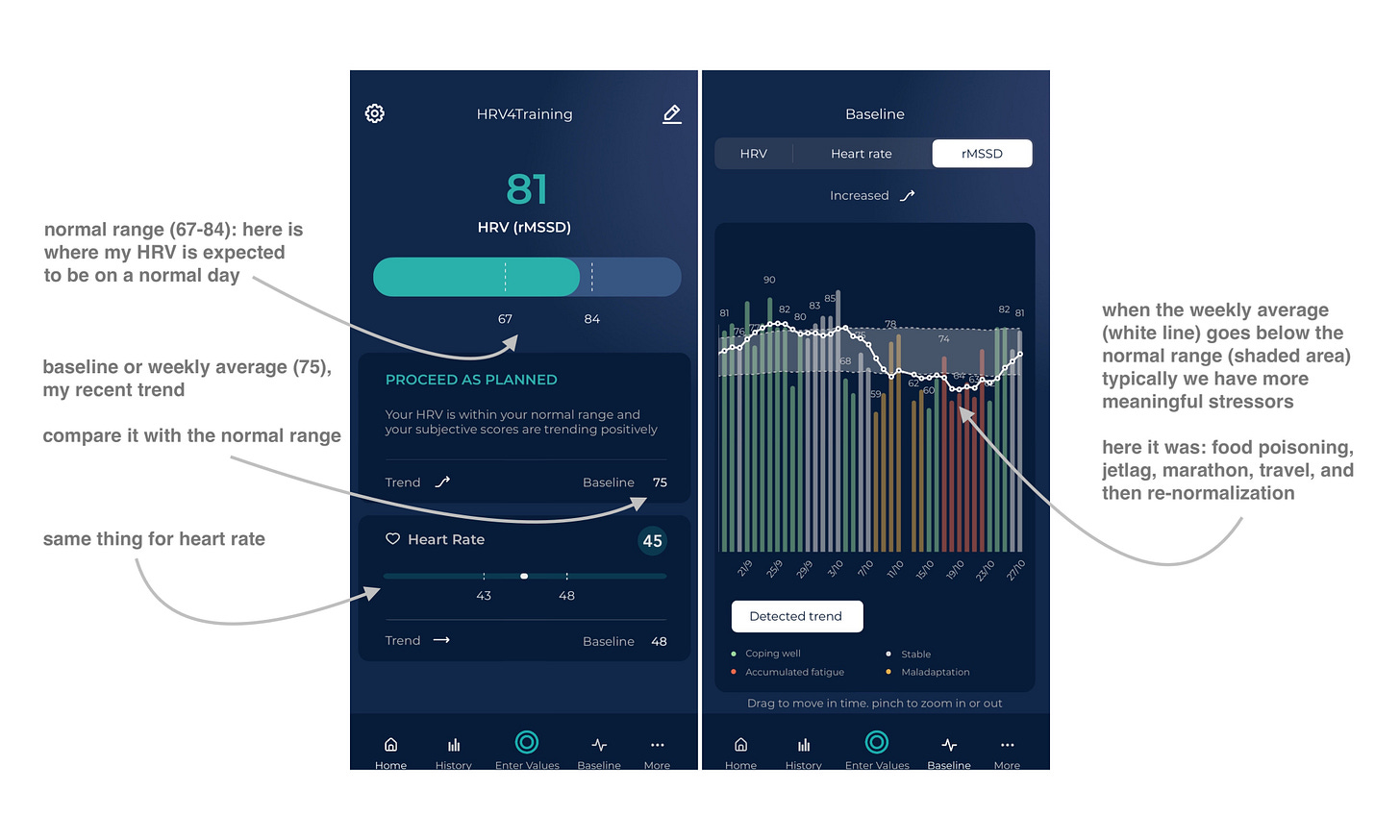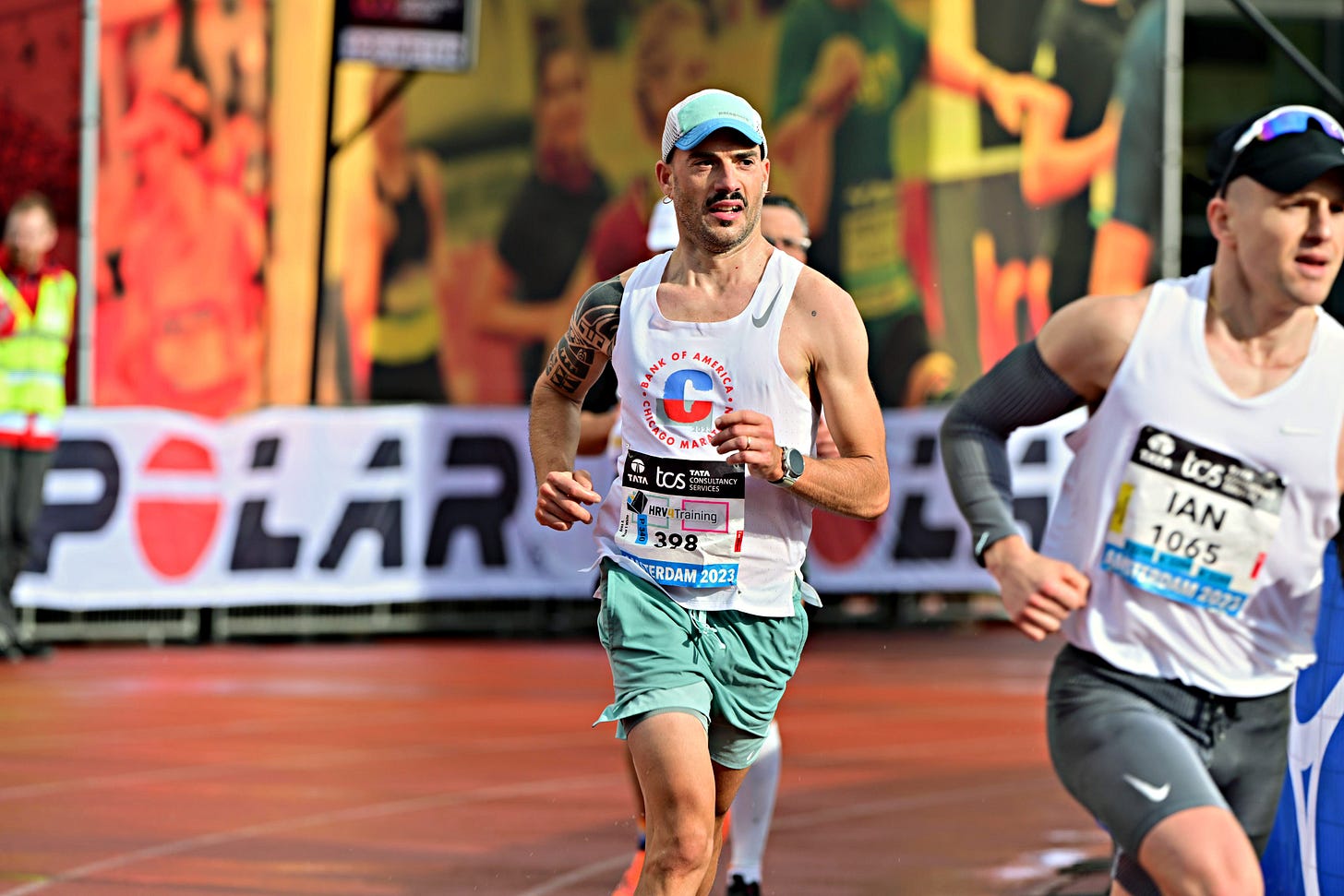Monthly Newsletter: October 2023
heart rate variability, wearables, entrepreneurship, training talk and some ramblings
hi there 👋
I hope all is well.
Here is my newsletter for October, with links to the individual articles I’ve written in the past month. I hope you’ll find them useful.
Please feel free to comment below or in the articles should you have any questions, and I will try to follow up.
Take care!

Heart rate variability (HRV) 🫀
Don't be too reactive. Wearables promote a very reactive approach, typically based on blind guidance. You are prompted to react based on made-up, cumulative scores (readiness, recovery, stress, etc.), with little focus on the long-term picture. Most importantly, you are not adjusting a plan, you are making it up as you go: that's not how you improve your health or performance. In my opinion, there is a better way of using the data we can collect. Learn how, here.
HRV4Training ambassador program. There are still a few days to apply for our ambassador program. Learning from athletes and coaches is an invaluable part of the journey, and I am looking forward to getting to know you and your experience. Please see this blog to learn more and apply.

Wearables ⌚️
Developing a healthier relationship with tracking. I came across an article in the Wall Street Journal highlighting how wearables are potentially driving individuals to obsessive behaviors and what I would consider an unhealthy and misguided relationship with tracking. As someone building tools that allow individuals to track a number of parameters, I often think about the implications, and how to do this in a way that allows us to keep track of potentially important parameters. In this blog, I discuss some of the choices I made when building HRV4Training, in an attempt to take a step in the right direction in the context of developing a healthier relationship with what can be useful indicators.
Focus on measurements. I see lots of confusion when it comes to wearables. In this short blog, I’d like to try to clear up one of the most important points. When you use a wearable, presumably to measure your body's response to what you are doing (stressors), you have two options: 1) Looking at the physiology. For example your resting heart rate, pulse rate variability, temperature, etc. That's how your body responded. 2) Using a made-up score that includes your behavior and as such, becomes some sort of self-fulfilling prophecy. Keep reading, here.
Podcasts / Talks 🎙️
Royal Society of Medicine. On November 7th I will be speaking at the Royal Society of Medicine (London). My talk will be on wearables for sleep and physiology tracking, how they work, validations, limitations, and practical considerations. You can find the program and registration here. Unfortunately, I won’t be in person at the event, but I will give a remote talk. I will try later on to summarize the main points in a blog to share in this newsletter.
Building 🛠️
HRV4Training Pro. I have released the new HRV4Training Pro and have written various articles that can serve as an overview of the different features. You can find the user guide here. I hope you’ll like the new platform, and would like to thank you for your support.
Aerobic efficiency update. What’s aerobic efficiency? Aerobic efficiency is computed as external load over internal load (e.g. pace over heart rate or power over heart rate). This is a good indication of long-term changes in cardiorespiratory fitness (and also the main predictor in all decent VO2max models).

Training talk 🏃🏻♂️🚴
ChicagoAmsterdam marathon. This year, after running the Biel 100 km in June, I planned a summer of training targeting the Chicago marathon in October. As it often happens, nothing went according to plan. I ended up getting injured, cycling a ridiculous amount of hours per week, getting sick twice on race week in Chicago, throwing up on the course, finding a last-minute bib for my home marathon on the following Sunday (Amsterdam), and racing a personal best. Here is my training and race report.Training log. As the name says, this is simply my training diary for the year.
No racing in sight for me now, as this was the last race of my season. Time to go back to building for what’s to come.
Thank you for reading and see you next month!
Archive:
Marco holds a PhD cum laude in applied machine learning, a M.Sc. cum laude in computer science engineering, and a M.Sc. cum laude in human movement sciences and high-performance coaching.
He has published more than 50 papers and patents at the intersection between physiology, health, technology, and human performance.
He is co-founder of HRV4Training, advisor at Oura, guest lecturer at VU Amsterdam, and editor for IEEE Pervasive Computing Magazine. He loves running.
Social:







One question I’ve had as I use HRV over the years: how is it that some days my subjective feeling can be so bleh (as after a not great night of sleep) yet HRV remains in the upper end of my normal range? What accounts for this sort of dissonance between the objective and subjective?